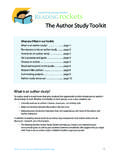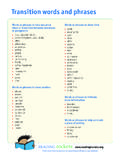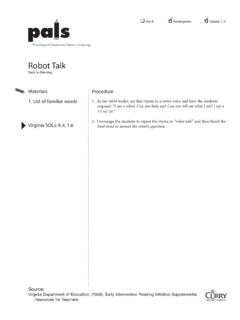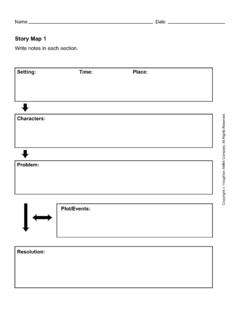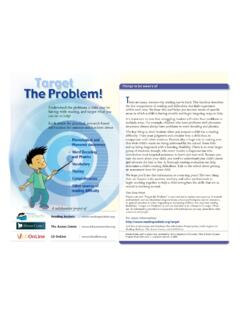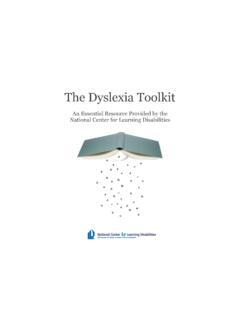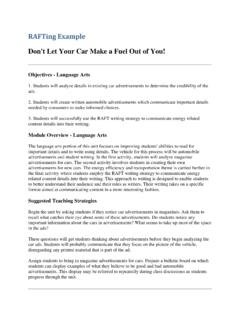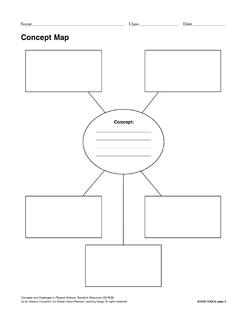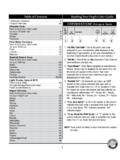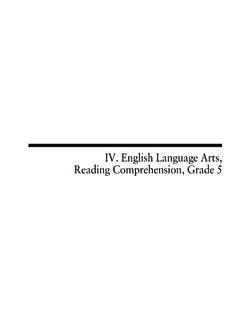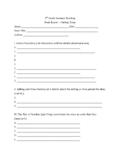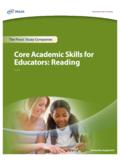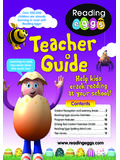Transcription of Teach 1 Shared Reading-FINAL
1 P-CHILD Teach 1 1 Shared reading An Instructional Strategy for Teachers Grades K 3 The ideas expressed in this work are generalizations and adaptations based on the Shared book method developed by Don Holdaway using big books. Description: Shared reading is an interactive reading experience that occurs when students join in or share the reading of a big book or other enlarged text while guided and supported by a teacher or other experienced reader. Students observe an expert reading the text with fluency and expression. The text must be large enough for all the students to see clearly, so they can share in the reading of the text.
2 It is through Shared reading that the reading process and reading strategies that readers use are demonstrated. In Shared reading , children participate in reading , learn critical concepts of how print works, get the feel of learning and begin to perceive themselves as readers (Fountas & Pinnell, 1996). Some of the benefits of Shared reading : Allows students to enjoy materials that they may not be able to read on their own. Ensures that all students feel successful by providing support to the entire group. Students act as though they are reading . Helps novice readers learn about the relationship between oral language and printed language.
3 Assists students in learning where to look and/or focus their attention. Supports students as they gain awareness of symbols and print conventions, while constructing meaning from text read. Assists students in making connections between background knowledge and new information. Focuses on and helps develop concepts about print and phonemic connections. Helps in teaching frequently used vocabulary. Encourages prediction in reading . Helps students develop a sense of story and increases comprehension. P-CHILD Teach 1 2 Setting and Resources: A sense of community is developed when the time is taken to arrange for a small group of students, or when appropriate, the whole class, to gather in an area near a big book, chart/easel, wall story, or text written on the chalkboard, so that all participants can easily see the enlarged text and engage in the experience comfortably.
4 Having a few items on hand during a Shared reading will allow the teacher or other experienced reader greater flexibility during the experience. Some items may include: A chalk board A pointing stick (with a rubber tip for safety when possible) File cards A post-it A highlighter marker These may be used during a session to reinforce teaching objectives for students. Additional information on how one might use these resources is available in the section called Shared reading of reading Materials: Shared reading provides an excellent opportunity for teachers to model the integrated use of the cueing systems and strategies for reading that can be applied to unfamiliar reading (for more info see Print Literacy K 3 Series).
5 New concepts and strategies are best introduced during Shared reading before guided practice or independent reading takes place. The Shared reading experience also provides the opportunity for the teacher to share different genres, or types of books, with students and familiarize them with some of their text features (Taberski, 2000). Following are examples of the variety of print materials that can be used for Shared reading : Shared reading Process:A Shared reading session may be conducted in many ways, depending on the needs of the students and the teaching objectives determined by the teacher. Shared reading with strong teacher support and guided reading with less teacher support are two ways the teacher can give students practice and immediate feedback, as they develop the skills and strategies necessary for successful decoding and comprehension.
6 This section will provide a brief description of how to conduct a Shared reading session. This description will be divided into three reading sections: Before, During, and After reading . Big books and lap books (see Appendix B) Wall charts/stories Poetry Chants or legends Songs Morning message Classroom news Language experience stories Text constructed and used on overhead projector P-CHILD Teach 1 3 Before: In Shared reading , the teacher introduces the story, talking about the title, cover, and title page. It is a good time to engage the students in what they see in the cover picture, and what they think it tells them about the story to be read.
7 Do not neglect the back cover of the book, as it often provides an interesting picture clue to what will happen in the story. During the introduction, the teacher conducts a picture walk through the book, briefly pointing out specific character actions or events, asking probing questions to engage the students in thinking about the pictures and story, but not telling the story. During: The very first reading is generally for enjoyment. The teacher points to each word as it is read. Students are asked to follow along with their eyes. Read the text as naturally as possible, phrased and fluent, though you may choose to slow the pace just a little for students to join in.
8 Model realistic reactions to the text and use appropriate voice intonation. Again, the teacher may pause from time to time asking students to predict a word, phrase or to make predictions about what is happening. During the read, the teacher may ask students to confirm their predictions by asking, Were you right/correct? After: After reading , the teacher can take students back to the point of making predictions, whether at the word or story level, and ask how they knew they were right or how they knew if their prediction wasn t quite correct. Giving students this chance to talk about their thinking is very powerful and ensures their full participation.
9 The teacher asks open-ended questions and helps students build connections to the text by activating students prior knowledge to the theme or main idea of the book. The second and subsequent readings allow for the students to chime in with now familiar words and phrases. In some cases, students and teachers can take turns reading ( , the teacher reads the left side and students read the right side). Other ways to extend the Shared reading experience can be found in the Extending Shared reading section. P-CHILD Teach 1 4 Shared reading Resources: The pointer may be used in guiding the reading , pointing to the words as they are read, though it is important that the teacher or other experienced reader model reading with phrased fluency.
10 Avoid the tendency to read word by word. In rereading of familiar text, students may be called upon to use the pointer during reading or to point out specific words being studied. Highlight with a yellow marker or highlighter pen the repetitive words, repetitive phrases, or frequently occurring words that the students already know. This can be accomplished with the students or prepared ahead of time. Have students read the highlighted words or phrases after the second or third reading , while the teacher reads the other words. Cover up (Post-It sheets work very well) to mask key portions of the text to focus on vocabulary or specific aspects of print, such as the beginning of a few words that support the learning objective or teaching point.
